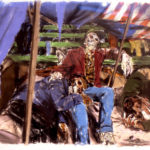Visual AIDS Artist Member James Romberger and Marguerite Van Cook are New York–based artists who, in 1984, opened the East Village gallery Ground Zero, which showed pioneering installation, performance, and multimedia work. One of their earliest artists was David Wojnarowicz, who they collaborated with on 7 Miles a Second, a comic book based on Wojnarowicz’s autobiographical writings. The couple most recently extended their collaborative relationship with the publication of The Late Child and Other Animals, drawn by James and written and colored by Marguerite. Below, they discuss their past, present and future projects with Visual AIDS.
Marguerite will be a panelist on Visual AIDS' upcoming LIVING POSITIVE & LONG-TERM SURVIVING: AN ARTIST PERSPECTIVE on April 23. More information HERE.
Visual AIDS: Can you describe the inspiration and process behind your new graphic memoir The Late Child and Other Animals?
Marguerite Van Cook: When I started to write my stories, I realized that I couldn't tell my own story without telling that of my mother. My relationship with her was not always smooth to say the least, but I wanted to try and understand her so that I could understand what had happened between us and what had happened to me. She wasn't married when she had me, which in the 1950s was a terrible sin that had to be hidden. Although, the writing process isn't confessional; rather I write to capture the happy moments and in the process explore the sad ones.
Visual AIDS: Collaboration is a central aspect of your work, and this project is written and colored by Marguerite while the text is adapted to comic form and drawn by James. Can you talk about the perks and pitfalls of collaboration, and how you negotiate the exciting but daunting process of working artistically together / with others?
Marguerite Van Cook: I know how good James is with textual adaptation and turning prose into a visual narrative and so I was really happy to hand him my stories. I write stories that have plenty of visual interest and dialogue, but it is James who adds the structure to the page and really does the work of animating the text. I generally enjoy the collaborative process because there is always someone to see your work when it is done--at the pace that you want it to be seen--and it is terribly exciting to see how someone else is interpreting your work and to see their creative process unfolding. Of course, you must absolutely trust and respect the people you are working with or it simply turns into a nightmare. The process allows each of you to bring your strengths to the table and produce something that is greater than anything that either of you would produce individually.
James Romberger: I wanted to adapt Marguerite's memoirs because she is a fabulous writer and I loved the autobiographical prose that she was writing. I was looking for a worthy follow-up to 7 Miles a Second and the stories of The Late Child and Other Animals are perfect. The most important theme that seems to carry through them is about society's tragic rejection of children who like Marguerite are born out-of wedlock, they form common scapegoats for society's ills and are ubiquitous plot-drivers for drama and literature. I fortunately knew her mother and was familiar with Portsmouth and the parts of France we showed and so I was personally invested in the stories. Marguerite's coloring adds immeasurably to the believability and cohesion of the artwork and storytelling, she is fearless in her color choices and always heightens the emotional resonance of scenes.
Visual AIDS: Why have you been drawn to the comic strip / graphic novel format throughout your career?
James Romberger: Comics are a barely-explored form of communication that utilizes text and art in tandem. Only barely emerged from the domain of children's pulp entertainment in this country, it is becoming clear that comics can support a range of material: for instance fiction, autobiography, journalism and educational purposes. In fact, right now the form's practitioners are involved in one of the most vital art movements around.
Visual AIDS: You worked closely with David Wojnarowicz on his autobiography graphic novel 7 Miles A Second. Any noteworthy anecdotes from creating that now cult classic publication?
James Romberger: I began working with David on 7 Miles a Second in 1986, while Marguerite and I were showing his art in our gallery Ground Zero, long before the graphic novel boom. My motivation was that I liked David and his work very much and I wanted to do something that pushed the boundaries of content in comics; this it certainly did. I felt and still feel that LGBT rights are one of the most important civil rights issues facing the modern world. For his part, David wanted to tell his story in the comics form, which he saw as a popular medium. He wanted the book to be published in as mainstream a form as possible to be accessible to the general public, and also he wanted it to reach young people, particularly LGBT youth who had gone through similarly abused childhoods, so they might know that they were not alone, that others had also trodden those paths and survived. In fact, David's original ending was about survival---he didn't begin the book thinking that he would die at the end. His diagnosis with AIDS came later. I regret that I wasn't able to finish it before David died, because we were both busy with many other projects at the same time that we were working on it. But, I believe he would have been pleased with the finished product and the positive response it continues to get. It has been perhaps the most widely-distributed of all his works.
Marguerite Van Cook: The first edition of 7 Miles a Second with DC comics had a print run of 25,000, which is a very big run in that world. It sold out. We always like to imagine the book being hidden under peoples' beds, because for a long time it seemed as if no one had seen it, but all the same, we knew it was out there. We felt a great affinity with our secret readership. The book was in the closet if you like, so it was only with the reprint that it finally came out. It is enjoying its hard-won freedom. Back then in its first edition in the 1990s, because of the limited technology, it had to go through a digital color separation process. The first company started working on it and then refused to handle it because of its content. The new version with Fantagraphics is exactly how we wanted it done and it is now available in all the regular bookshops. Now I'm happy to say that the book is out and knows exactly who its friends are. David and James had set out to produce something that would be widely accessible and I think that has now happened.
Visual AIDS: What are you looking forward to working on now that The Late Child and Other Animals is published?
Marguerite Van Cook: I have two themes in process, one is about my time with The Innocents in London during the punk years. My experiences touring with The Clash is only a small part of that narrative. However, the other story, tentatively called "Week Nights," is about my times with my queer friends in Portsmouth during the late sixties ("gay" was barely in use as yet). They used to go out mainly on week nights when they were less likely to be observed and could escape detection, which I only just realized. Weekends were a lot more sober. The emeralds were all put away. I knew a lot about hiding myself, so we got on well. On Wednesday nights, well, what didn't we get up to? "It was the best of times, it was the worst of times," to quote Dickens, a fellow Portsmouthian.
James Romberger: I am expanding my Eisner-nominated comic book Post York for Uncivilized Books into a full graphic novel. It is an ecological story that postulates a future New York that is flooded after the melting of the polar ice caps, that incorporates cinematically-inspired narrative devices. The main character is based on our son Crosby and he contributes his music to the project; one of his songs was produced as a flexidisc that was bound into the book, which is also available as an online download.
Visual AIDS: What is one takeaway you hope readers will have when reading the graphic memoir and how have audiences received it?
Marguerite Van Cook: I'd like readers to know that The Late Child and Other Animals is truthful. I think we all want to be seen and heard for who we are. Some of the good reviews have been very touching, for just that reason. It seems that when people actually read it, they find the work speaks to them. James' drawing is just gorgeous in this book. It was an absolute pleasure to color him.
James Romberger’s fine art pastel drawings are in many private and public collections, including the Metropolitan Museum of Art. Romberger's ecological comic Post York was published in 2012 by Uncivilized Books; it includes a flexi-disc by his son Crosby and it was nominated for a 2013 Eisner Award for Best Single Issue. Romberger collaborated with Marguerite Van Cook on the 2014 Fantagraphics Books graphic memoir The Late Child and Other Animals; with Guggenheim fellow Jay Cantor on the Vertigo graphic novel Aaron and Ahmed: a love story; and with Van Cook and the late writer, artist and AIDS activist David Wojnarowicz on the critically acclaimed graphic novel 7 Miles A Second, whichwas first published in 1996 by DC/Vertigo and then released in a revised, expanded edition in February 2013 by Fantagraphics Books. Romberger interviews authors for Publisher’s Weekly and he writes critically for The Comics Journal and the pop culture site The Beat.
Marguerite Van Cook came to New York her punk with band The Innocents, after touring the UK with The Clash. She stayed and opened the seminal installation gallery Ground Zero with her partner James Romberger. Her own works as an artist and filmmaker have placed her in many museum collections, including the Museum of Modern Art and the Schwartz Art Collection at Harvard. Her other credits include poet (she was awarded the Van Rensselear Prize while at Columbia) and actor. Her current generational graphic memoir The Late Child and Other Animals with James Romberger (Fantagraphics) has been translated and published in France under the title L'Enfant inattendue. Her color work on the graphic memoir 7 Miles a Second, a collaborative project with James Romberger and the late David Wojnarowicz garnered her a nomination for an Eisner Award 2014 for Best Painter/Multimedia Artist. In 2006, Van Cook became the creative and managing director of the Howl! Arts Festival, where in 2009 she helped establish Howl HELP, a free emergency health & care service for downtown artists. She holds an M.A. in Modern European Studies from Columbia University and is currently completing a Ph.D in French at The Graduate Center CUNY.





